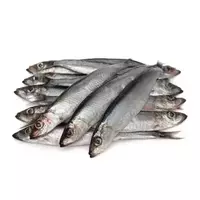Salted sprat

For several decades, salt sprat has been considered the favorite treat of most of the inhabitants of our latitudes. Once upon a time, the sprat of spicy salt was jokingly called a real Soviet "delicacy. " Apparently because in those days only fish like sprats could be easily purchased in any grocery store. Sprats were a frequent guest on our mothers and grandmothers' tables. A jar of salt sprat has always been stored in the homes of Soviet hostesses.
Sprat is the common name for several subspecies of fish that belong to the Herring family. It is noteworthy that the famous sprats are also referred by scientific classification to the Kilek species. However, real sprats have a more refined taste, and therefore are considered a first-class fish canned product. Sprat fish is considered a truly folk food, primarily due to its availability and low price.
In addition, sprats are distinguished by their vitamin-mineral composition, which is not inferior to other nobler varieties of fish. The calorie content of salt sprats, as well as sprat fish, is at a fairly low level. However, the calorie content of the salt sprat may vary depending on the method of producing the food. Sprats are classified as important commercial fish. The harvesting of sprats on an industrial scale is carried out in the waters of such main habitats as the Mediterranean, Black, as well as the North, Norwegian and Baltic Seas.
Sprat got its distinctive name due to its peculiar structure. On the belly of the fish there are scales that look more like spikes and help the sprat in disguise, as well as serve as a kind of keel when moving. There is a huge species diversity of representatives of the Herring family and almost all of them are eaten. For the first time, salted sprats were made by residents of the Baltic Sea coast, where sprats have been eaten since ancient times.
Over time, the recipe and ways of salting sprats have changed. Currently, the traditional Tallinn sprat of spiced salt is very popular with foodies and connoisseurs. In addition to the Baltic states, salted sprats are produced in the Russian Federation, Norway, Ukraine and Yugoslavia. Salted sprat can be purchased from any nearby store. Usually salted sprats are sold in canned form. However, such a product will not be able to compare with a freshly salted sprat made at home.
The recipe for salted sprats is simple and will not require large time and financial costs. In order to prepare a salted sprat, you need to purchase a kilogram of fresh fish, wash the carcasses and fold them into wooden or enameled dishes. First, salt and spices should be placed on the bottom of the container. Sprat should be laid out in the dishes in rows and each new row should be seasoned with salt and spices. The low-salted fish will be ready in 12 hours. However, salty sprat is completely ready for use only a day after salting.
salted sprats 137 kCal
The energy value of sprats is salty (Ratio of proteins, fats, carbohydrates - ju):
Proteins: 17.1 (~ 68 kCal)
Fats: 7.6 g (~ 68 kCal)
Carbohydrates: 0 g (~ 0 kCal)
Energy ratio (bj | y): 50% | 50% | 0%
 Español
Español Français
Français Português
Português Русский
Русский 简体中文
简体中文 繁體中文
繁體中文 日本語
日本語 한국어
한국어 العربية
العربية Türkçe
Türkçe Қазақ
Қазақ Deutsch
Deutsch Italiano
Italiano Українська
Українська
